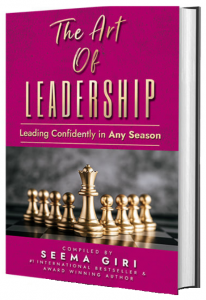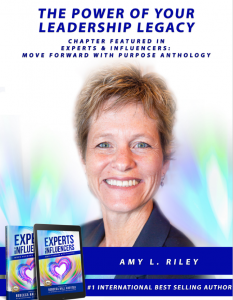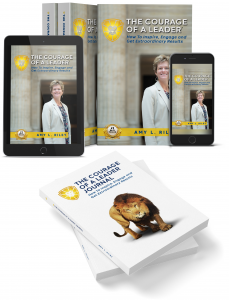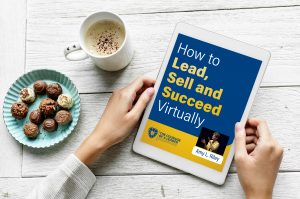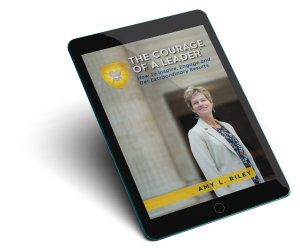My guest on today’s episode of The Courage of a Leader podcast is Megan Robinson, principal at E Leader Experience. Megan is talented at describing complex, nuanced, leadership concepts in accessible, simplified ways.
In this episode we discuss how to be an agile leader, and how agility is most effective when built on the foundation of knowing who you authentically are as a leader.
About the Guest:
Megan Robinson is the principal at E Leader Experience and works with individuals and teams to develop self-leadership skills that grow companies. She started her career in marketing moving her way through the corporate ladder at advertising agencies and Fortune 500 companies before jumping into the entrepreneur pool. It was at that first company that Megan discovered that her true passion was the transformational process of coaching, and so she became a John Maxwell certified coach and DiSC Trainer.
In addition, Megan is the Past President of ATDChi the leading learning and development organization in Chicagoland. Inspired by her own successful career in corporate and entrepreneurial environments, Megan makes leadership approachable for everyone, regardless of title, position, or experience.
The best way for people to reach Megan is at megan@eleaderexperience.com
LinkedIn Profile: https://www.linkedin.com/in/tritcak/
https://www.eleaderexperience.com/
About the Host:
Amy L. Riley is an internationally renowned speaker, author and consultant. She has over 2 decades of experience developing leaders at all levels. Her clients include Cisco Systems, Deloitte and Barclays.
As a trusted leadership coach and consultant, Amy has worked with hundreds of leaders one-on-one, and thousands more as part of a group, to fully step into their leadership, create amazing teams and achieve extraordinary results.
Amy’s most popular keynote speeches are:
The Courage of a Leader: The Power of a Leadership Legacy
The Courage of a Leader: Create a Competitive Advantage with Sustainable, Results-Producing Cross-System Collaboration
The Courage of a Leader: Accelerate Trust with Your Team, Customers and Community
The Courage of a Leader: How to Build a Happy and Successful Hybrid Team
Her new book is a #1 international best-seller and is entitled, The Courage of a Leader: How to Inspire, Engage and Get Extraordinary Results.
https://www.linkedin.com/in/amyshoopriley/
Link mentioned in the podcast
How to Use What We Know About Neuroscience to Be Exponentially More Influential (podcast episode): https://courageofaleader.com/captivate-podcast/how-to-use-what-we-know-about-neuroscience-to-be-exponentially-more-influential-with-laura-berger/
The Courage to Be An Inclusive Leader (podcast episode): https://courageofaleader.com/captivate-podcast/the-courage-to-be-an-inclusive-leader-with-ellen-burton/
Innovative Ways You Can Create a More Sustainable World (podcast episode): https://courageofaleader.com/captivate-podcast/innovative-ways-you-can-create-a-more-sustainable-world-with-simon-bailey/
The Inspire Your Team assessment (the courage assessment): https://courageofaleader.com/inspireyourteam/
Thanks for listening!
Thanks so much for listening to The Courage of a Leader podcast! If you got inspired and/or got valuable leadership techniques you can use from this episode and think that others could benefit from listening, please share using the social media buttons on this page.
Do you have questions or feedback about this episode? Leave a comment in the section below!
Subscribe to the podcast
If you would like to get automatic updates of new The Courage of a Leader podcast episodes, you can subscribe to the podcast on Apple Podcasts. You can also subscribe in your favorite podcast app.
Leave us an Apple Podcasts review
Ratings and reviews from our listeners are extremely valuable to us and greatly appreciated. They help our podcast rank higher on Apple Podcasts, which helps us ignite The Courage of a Leader in more leaders! Please take a minute and leave an honest review on Apple Podcasts.
Teaser for next episode
Tune in to our next episode, Value-Driven Growth: The Magic of Clarity to Create and Convey Success with guest Mark Stiving.
Transcript
My guest on today's episode of the courage of a leader podcast is Megan Robinson, principal at EA leader experience, Megan is talented at describing complex nuanced leadership concepts in really accessible and simplified ways. In this episode, we discuss how to be an agile leader, and how agility is most effective when built on the foundation of knowing who you authentically are as a leader. I'm glad you're here to listen to Megan, and to ignite the courage of a leader in yourself.
Amy Riley:Welcome to the Courage of a Leader Podcast. This is where you hear real life stories of top leaders achieving extraordinary results. And you get practical advice and techniques, you can immediately apply for your own success. This is where you will get inspired and take bold, courageous action. I am so glad you can join us. I'm your host, Amy Riley. Now, are you ready to step into the full power of your leadership and achieve the results you care about most? Let's ignite the Courage of a Leader.
Amy Riley:Megan, I know that we are both excited to have this conversation today. There's many things leadership related that you and I could have talked about. And we decided to focus our discussion today on leadership agility. can you start us off by explaining how do you define or think about leadership, agility,
Megan Robinson:leadership, agility touches so many aspects and I think is almost synonymous with the term leadership. And that it's a skill set. It's a need, it's something people are looking for right now. And really making sure that you're approaching situations people, the market, the organization with some sort of flexibility, adaptability. And that ability be collaborative, is really where I look at those core aspects of having an agile leadership approach. And I've noticed a lot of people are looking for leaders that are able to shift and be agile and flexible. Because we have changing circumstances that are happening so much faster. These days, I don't need to tell anyone how quick the world is moving. And having that agility to address it. I look at it as leadership agility from a team perspective, and meeting people where they're at. And that flexibility in your style takes a sense of agility as well. So that's, that's really where I come at when I think of leadership agility as a skill set as a need, as a way of behaving, to the realities that we're facing every single day as leaders.
Amy Riley:Terrific, I love it. And again, it's a skill set. It's a need. It allows us to be flexible. It allows us to collaborate and effective ways. It allows us to meet people where they're at. How do we know? What's needed? Right? How do we know? Okay, we might even recognize this as an opportunity to be agile, right? Here's it. Here's a team member and a new set of circumstances. How do we do that? How do we meet them where they are?
Megan Robinson:I love looking at teams and getting out of your own space with leadership, where so much of leadership, I think is often taught of how do you show up as a leader? And what is your leadership style? And how do you define your leadership. And those are incredible skills. And really that starting point that you need to understand before you're able to be more agile, flexible. The ability to be flexible, and agile as a leader is that secondary skill set that gets layered on top of once you build that confidence and that courage from leadership, because it takes so much more to be able to be agile with what you've learned. And so I look at people and teams, particularly when it comes to Agile leadership, of where are they and how does that align with your intention and your goal and being able to meet so that you understand their perspective or you're open to what's happening with them and you're able to have that more collaborative approach? Because oftentimes, and I'm sure you've seen the kind of go in there, the authoritative leader, or they're just all this is my way or the highway and this is what's happening. And there is no flexibility there. There is only my way and being able to understand Have a little bit of that empathy, or perspective shift, or making sure that your message in your vision is interpreted correctly from the other person takes time and energy. But that's where real leaders succeed.
Amy Riley:Excellent. I heard a couple of things in there, Megan. One is before we can be agile and meet the person, like put that on a foundation of who you are, as a leader know what your core style and the commitment of your leadership, I call it a leadership legacy, right? Where our strengths were our passion, what's important to us to provide as a leader. So we know that within there's different ways that that can show up, and we can provide that. And then I heard heard you looking at, okay, this individual, where did where does the leaders intentions and goals line up with the person's intentions and goals and abilities? And there's probably more their skill set. Okay, I love that Venn diagram.
Megan Robinson:Decoupling that a little bit where you talk about that, that leadership foundation that you worked so hard on building, I'm gonna say that's kind of the what are your why for a lot of people look at, you know, that that's what's bringing that core, how you execute on that. That's where the agility comes into. Being able to change your strategy, being able to change your communication style, to meet that other person. That's where being agile in the delivery of it, you have not ever and that's where I think having that authentic leadership, knowing who you are, knowing your intentions is so critical, because otherwise agile leadership can be looked at as wishy washy or fluid, right?
Amy Riley:This side stunt Yeah, like, we don't know what to expect from you, leader, you're always shifting.
Megan Robinson:Yeah. And so bringing that type of toolkit of the communication and getting that how out there. Once you know what you're talking about, once you know why you have that intentionally, once you have that really strong foundation that you're able to build, then being able to move into how you connect that with others.
Amy Riley:Nice, I love this way of thinking about it, you know your why, as a leader. And then leadership agility is how we are showing up for each set of circumstances, each team member and so on.
Megan Robinson:And I will even say that goes I mean with everything moving fast and industries now, and so much change. That's the same for organizations, when they build their strategy, you have to know what you're trying to accomplish, what that end goal looks like, just as much so that you can be shifting in the strategies and the executions along the way. If you just barrel down or or even stick your head in the sand, and keep trying to do the same thing over and over again, without understanding the landscape. Without meeting the market where it's at, you're going to get lost, you're going to get forgotten and you're going to get stale.
Amy Riley:Ah, nice tie. I like that way of thinking about it in the organization. You've got your core, what's our vision, what's our mission? And then the how the strategies our approach is just for every leader to think about that for their function for their growth for the work that their team does. Okay, Megan, let me tell listeners more about you. My guest today is Megan Robinson and she is the principal at E Leader Experience and works with individuals and teams to develop self leadership skills that grow companies. She started her career in marketing, moving her way through the corporate ladder at advertising agencies and fortune 500 companies before jumping into the entrepreneur pool. It was at that first company that Megan discovered that her true passion was the transformational process of coaching. And so she became a John Maxwell certified coach and DISC trainer. In addition, she is the past president of ATD Chi that's the Association for Talent Development Chicago chapter. And that's the leading Learning and Development Organization in Chicagoland inspired by her own successful career in corporate and entrepreneurial environments. Megan makes leadership approachable for everyone, regardless of title, position or experience. And I know I've experienced that with you beggin I've said that to you, you take complex leadership concepts and you make them understandable, approachable, you give folks an access point. So I'm happy that you're here today on the courage of a leader podcast.
Megan Robinson:Thank you so much, Amy. I appreciate that so much. And it's so important that people are able to show up with these skills, no matter how they identify as leader, whether they see that leadership moment. And when you're starting to say that I was thinking of all the times that you really need to be agile in your job function, whether you're that individual contributor, or in the agility you're looking for from a CEO. Yeah. And that's for all leaders, your clients, the people you're working with, who you're collaborating with, is always shifting and being able to meet them with that skills, having that same intentionality that you work so hard to really build out that foundation helps. And most every level,
Amy Riley:maybe what can you offer to a leader who says, okay, yeah, I got this concept, right. And I have a variety of situations, I have a variety of team members, and I have new information coming in. I know, I need to be agile in moments. So if we have the awareness, how do we assess in the moment? What's needed? I mean, I've heard we've heard a little bit of looking for the Venn diagram, right? How do intentions and goals line up? But how do I determine especially in fast paced situation, right, what's needed here? And how do I bring that?
Megan Robinson:I love that question. Because it kind of dives into some of those skills, I'm going to say this is where listening is such a key skill. And I know you talked about listening, I love talking about listening, it's so underrated, so undervalued. And so critical, because if you are not listening, you are not able to be agile, you are just bulldozing through, you're not addressing the realities of situation, you're not listening with curiosity, to understand more of your circumstances. And I think in that ability to be agile, you're really having a sense of vulnerability. And it's balancing, like most things in leadership, straddling two different ideas at the same time, right, you want to have your goals and your intention, and your what, and then you need to be able to be open to change and to reach shift those ideas. And to not not change who you are. But being able to be adjust and flexible. No matter how inflexible your passion is.
Amy Riley:This is really great. Megan, I'm glad that you weren't immediately to listening, I think a lot of leaders can fall into the pitfall of thinking, okay, new set of circumstances, I'm going to sit in my office by myself. And I'm going to analyze this and I'm going to figure out what's needed. But you're saying we're listening. So we're doing this with others, in a vulnerable emergent kind of way. So we're coming in, we're asking questions, we're finding out where people are at. And CO creating, is that fair to say what's needed?
Megan Robinson:I love the CO creating Word, I'm gonna say that takes collaboration on steroids, right? Like, oh, we're collaborative. When you're like, No, we're co creating. That's where you're like, No, there's something new that's coming from that. And you're really working together for that common goal. And that's where I think co creating gets exciting, because collaborating, you may be sharing those ideas, you may be half heartedly listening, I'm gonna say. But when you're co creating, you're aligning on that same goal, and you're bringing both of your expertise to the table, both of those perspectives, so that it continues to evolve, I think. And that's where I was even looking at innovation as one of those those key components. And I actually don't think that you really need to be innovative. If you're in this agile space, you have to be able to meet other people and bring the best out of them. And that's where the innovation comes from. And if you put all that pressure on yourself, as you said, to go into your whole or your office and try to find everything out and map out your new perfect strategy. You're not being innovative, you're not tapping into the genius of others. And when things are moving fast, when there are new things that you're unaware of, if you're not listening, if you're not willing to be a little bit vulnerable, and understand that you don't have all those pieces that isn't perfect. It's putting more and more pressure on you instead of CO creating and in that collaborative space where you're going to have the best results.
Amy Riley:Excellent. I love this. So we come become aware that agility is needed. We get we get curious, and we go out with people and then what's needed emerges. And then also, the facilitator was coming to mind like we're facilitating people bringing their best ideas to the table. We're facilitating a process so that people are able to do that, rather than needing to be the leader who somehow comes up with all of the amazing innovative ideas, but no instead how can we tap into the people and the ideas and the experience around us.
Megan Robinson:s been desirable. In the last:Amy Riley:longer. I was thinking the same word, man. Yeah. Yeah, just because
Megan Robinson:with that, you're your mentoring, you still have that vision, you're not letting go of that, what you're not letting go of your why. But you're really working with the other people to align on that you're coaching them on those other ideas, you're mentoring and guiding them from your own expertise and sharing that in a productive way. That's not just dictating the next steps. And that's what's really fostering that environment for that innovation when you are and I'm going to say, mostly being that open minded. And that's really, I'm gonna say right next to that awareness, setting, that open minded perspective is what's going to really get that foundation so that you can start doing this fun stuff.
Amy Riley:So you mean, instead of having all of the answers, I just open minded and curious, and use a coaching approach to find out what others are thinking.
Megan Robinson:Yeah, and I think it's I always in this has always been my personal kind of mantra of having that strategy, having that plan, and then being open to what happens. And it's great when you have and I'll say a lot of times with leadership, it's that vision, right? You have that vision. But if you get so narrow focused on it, and you don't leave yourself open, if you're not continuing to listen, if you're not continuing winning, you'll ever sailboat analogy, right? You're always going to kind of have to tack a little bit to get there. Yes, that's what's what's kind of missing, I'd say in that mindset of keeping open. Yes,
Amy Riley:I love have the vision have the plan. But we've got to have our heads up. This is one I always need to hear personally met again, because I get a plan. I get excited about the plan. It makes sense. I want to execute the plan. I've got dates and names and ideas next to the plan. I just want to keep going. But we've got to have that commitment. So maybe this May this leading into my next question, right, like, how do we keep that open mindedness? I think some of it is is a commitment to doing so right? Just keeping that sometimes I say post it notes can be transformative, you know, like, be be open to new ideas be open to needed shifts in the plan, or you just have that post it note or computer can be transformational? Maybe checkpoints like how else do we let that in when it can be easy to get locked into a plan. It's so easy
Megan Robinson:to get locked into the plan. And this is where that what are that why in that how gets separated? I don't want anyone to get locked into the plan. Because the plan is not the end all be all. The plan is just the strategy of how you're going to get there. You want to keep your y much closer than your plan. Okay, yep. And if you're able to decouple those two, and they are not the same thing, that's where you stay open minded.
Amy Riley:Love it. The Y is our guiding light our North Star, not this strategy to become married to because maybe and
Megan Robinson:then you're able to use that Guiding Light, you're able to evaluate those new situations against it, you're able to know do we need to bob and weave? Or do we need to stay with the plan? Is it the plans fall? Is it the markets changing? Is it that we didn't I was just coaching someone yesterday about changing strategies and outcomes. And we were having the conversation of okay, well, did we really work the plan? We're not getting the desired outcome, and we're not working the plan. So is it the plans fault? Do we need to change for a new strategy? How do we evaluate when that's time? Is it the market? Do we need to have something more digital? We actually don't know. Because we didn't work the plan. Sometimes you have situations where you work the plan and you're like, we did the best we could or I learned the term audible a couple years ago, you've got to pull an audible halfway through. Because you realize your plans not going in the right direction. Yeah, so football tournaments where they kind of change plans get straight, right? If you see it and you don't have your head up to know if your plan isn't aligning or if it's going to take you in a different direction. You've got to be able to pivot.
Amy Riley:Yes, great analogy. I have a quarterback in the house. I'll share about this podcast episode with him tonight he'll get it. But this is really important because we're talking leadership agility. We don't want people to think this is the new fad of the week or you know, not. It's the why that stays consistent. And if we can continue to talk about that, why, that's what stable. And then if we try a how, and it doesn't work, right, then then there's a new how, but it doesn't mean that we're throwing everything out. Right, I think that can help people feel like like it's not discombobulated. Now now we're doing a now we're doing B, now we're doing C, well, a, b, and c are all strategies of how we think we might possibly meet our why. But we got to work the plan of a to find out if that strategy is working.
Megan Robinson:Absolutely. And I love especially for people that are a little slower to change. And it's harder for them to adapt, or it's harder for them to adjust. When you are really clear on those elements, you're able to give them that answer. Well, why are we changing this? What's happening? You know, it's clear, because you're saying, This is what we want to achieve. This is why we don't think it's going to get us there. And you're again, collaborative, and opening up that conversation of this is what we're seeing, you're helping the rest of the team expand and strengthen their critical thinking skills. Because they're seeing how you're processing it. They're moving through different questions that they may not see. They don't have the visibility yet. They don't have the experience with it. And so you've created an even stronger connection, even stronger skill development opportunity. But you also get them on board. Because everyone wants to succeed. And when they're already invested, and you've done the hard work of really having that strong why they're ready to to abandon one plan and jump for another one. If they can see the path ticket there.
Amy Riley:Yeah, yeah, if they understand the rationale. Yeah.
Megan Robinson:And nothing's gonna burn out your team faster than if you're on a path and they all think it's not going to work. Right. And that, that happens all the time, too. Right. Someone's so when you are so dedicated on that plan, you're like, we're going to make this work hell or high water, it is happening. And no one's on board. No one, no one really cares. No one's invested. They all are waiting for it to fail.
Amy Riley:Yeah. So call an audible. How do we get everybody on board?
Megan Robinson:This is going into change management. Right? Yeah. How, and I see a lot of leaders struggle with that shift, especially when it is so clear for them. And I, you know, you work with a lot of intelligent people you get, and they forget what it's like to be in that other place or position, or to not see the whole chessboard. And so it is painfully obvious for them. They're like, well, decision made, let's go. And everyone else is like, what just happened? Why are we doing this completely uncomfortable, all the emotions start to turn. And that's where that coaching, that mentoring, that listening, bringing people in as part of that plan. And part of that process of how you evaluate it to get to that decision can be so critical, but most importantly, is realigning them to that why?
Amy Riley:Uh, well, the analogy of the chessboard, show them the whole chessboard, right, and let's, let's talk about this, let's the mentoring, like, let them know what you see from your experience and your expertise, and the coaching, right? What do you see what ideas where are the obstacles going to be? I help us help us make this plan as successful as possible.
Megan Robinson:I actually taught my father in law How To Play Chess this week. And so it was a really fun experience of watching someone understand, build their strategies out. And, you know, you really have to understand how all of those pieces move, because each piece moves a little bit differently in chess and trying to keep that in mind. And giving them enough of that time and having some of that patience and letting them make a mistake or to or before they're, you know, when they're figuring things out, letting them say, Okay, well, if we do that, let's play it out what's going to happen, and having those types of conversations that start building that level of expertise, because now your whole team has something new that they can look for. They understand that decision making process, you've coached them and mentored them in a way that is invaluable where they didn't have to make those mistakes. They got to learn from it beforehand.
Amy Riley:Let's talk about the different possible chess moves. And what might happen from here? I love it. Maybe one more question, Megan. So we said that first you want to define your leadership. And then we can be agile on top of that foundation. As we continue to practice leadership agility, how do we make sure that we are being true to our authentic selves? As we're diving into conversations and CO creating with others?
Megan Robinson:I always love setting intentions. That's one of my big questions I'll ask clients, it's something I've reflect on before any situation is, what is my real intention? What is my outcome? And that is, that can be a big why, right? We've talked about big vision pieces and having all that it can be real small. It's the feedback that you need to give someone the tough conversation, you're walking into the the delegation that you need to handle, okay, and those are much smaller intentions, that you have a conversation, right, you're not jumping in with how you're going to change the world. It's, here's what I need someone to understand. Or this is the feedback they need, or this is the outcome I want them to create, or this is, this is what we need to co create, or this is what I want them to walk away with. Or this is what I need from them. Understanding that intentionality in the conversation before you jump in, helps you be more agile, because it is not about your style, or how you say something, it's how are they going to get closer to that. So you're not losing anything that you need in the conversation. It strengthens your conversation, and gives you permission to be more flexible in how you're communicating and how you're addressing the situation and keeps you on track. More than anything else.
Amy Riley:I love that I love that we can set an intention for five years, we can set an intention for the next conversation. And I feel like at the same time it grounds you and enables that flexibility, right like here, here's what this is going to be about. I know that if my intention is to co create a solution with someone I know I'm going to show up as a listener, I know I'm going to show up curious. So there's some grounding there. But then you've also got to be flexible to see how we're going to get to that intention and outcome.
Megan Robinson:It's a little bit I have a good friend, another coach and facilitator that there's a lot of improv. And I always, I always revered I'm like oh my gosh, your experiences and in that improv situation where you're building off of that in that constant situation. That then as we talked about straddling those two ships, right, you have the intentionality and you have a goal. But being able to have that flexibility and improv that comes because you don't know what's going to come in that conversation and making sure that they're able to meet instead of going in opposite directions, or I think there's a ski I never was a good water skier, or snow skier. Right? Like you want to keep those skis aligned and together. And if they start veering off in opposite directions, you are in trouble.
Amy Riley:You are You are so great at the analogies. And I love this tie to improv. So even though I'm super comfortable being on the stage as a speaker or facilitator, I would not want to be on the stage as an improv actor. But I love that core skill of Yes. And that improv actors practice. It's it's not okay, someone's taking the scene in this direction. And now I'm gonna hijack that and try to take it somewhere else, like how do I build on what is being created by my co worker? My fellow actor here in the moment?
Megan Robinson:100% It's, it's my number one rule. I've never taken an improv class. But I know the yes and rule. And I will say that that's been changing for leadership. It's been changed that one word can keep you in that open minded space. It can make you more open and more flexible to what may come with you. And I think it's a great first step in being more agile as a leader.
Amy Riley:Yes. Megan, you have shared so much great stuff with us. I'm going to recap some of it here for our listeners at the end of the episode. It starts with awareness. Right? It starts with knowing who you are. What is your leadership style, and foundation. What are you about and then it is jumping in to be curious. Write curious, listen, be willing to be vulnerable, to be able to create that CO facilitation, facilitate the process and getting others involved and hearing their ideas. That's what can truly create innovation. It doesn't have to be on you, leader to come up with all the innovative ideas to be the problem solver for an for everything. I wrote the transition from probe Problem Solver to coach right using that coaching approach, bringing others in. Be open minded, you know that you know, the why the vision where you're headed. It's the how that you're agile about that you shift and try different things over time, call an audible. setting intentions is a powerful practice, whether it's for the five year vision, or it's for the next conversation and the practice of Yes, and to build on others ideas to bring others into the conversation. Thank you, Megan, for all of your wisdom analogies. You do make concepts accessible, easy to understand and think about. I really appreciate you being on the Courage of a Leader podcast.
Megan Robinson:Thank you so much, Amy. It has been an absolutely fabulous time. I love the work that you're doing. I'm so glad we could have this conversation together.
Amy Riley:Me too. Thank you, Megan.


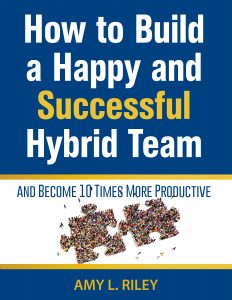
 A Summary of The Courage of a Leader® 4 Pillars
A Summary of The Courage of a Leader® 4 Pillars